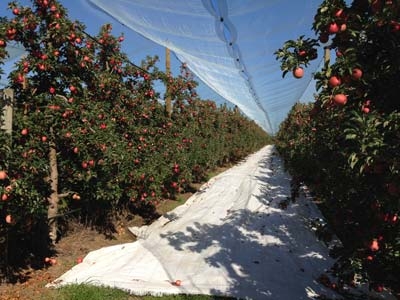Crop load (continued from last month)
Crop load
Crop load is known to influence colour development.
Excessive load with fruit clusters of two to three fruits can reduce blush through direct shading of neighbouring fruit, or through competition for assimilates needed for increased blush (Gurnsey & Lawes 2014; Fox 2014).
Regulated deficit irrigation
Regulated deficit irrigation (RDI) reduces vegetative growth thereby allowing more light to penetrate the canopy and colour fruit, however, RDI will reduce fruit size.
Root pruning and trunk girdling/scoring
Root pruning and trunk girdling (or scoring) are also likely to benefit blush by curtailing vegetative growth and reducing shading but care must be taken to avoid water stress that will reduce fruit size.
Reflective cloths and films
Reflective cloths and films, sometimes called mulches, can be placed on the ground surface between tree rows for two to four weeks before harvest. They reflect light back up into the tree canopy and can increase red colour (Figure 1).
Effects of nitrogen
Many studies have reported that red apple colouration decreases as application rates of soil or foliar nitrogen increase (Wang & Cheng 2011) but more research needs to be focussed on Cripps Pink grown under Australian conditions to fully understand the impact of nitrogen on colour development.
One way nitrogen can reduce red colouration is by increasing foliage production, leading to shading and less light penetration into the canopy.
It is now also understood that increasing nitrogen supply delays red colour development by decreasing both anthocyanin synthesis and chlorophyll degradation in apple skin.
Orchard management systems need to supply enough nitrogen to optimise tree health and yields without allowing excessive nitrogen concentrations to build up in the foliage and fruit.
Application timing
Timing of soil and foliar fertilisation is important.
Applications that are made in spring during periods of rapid vegetative growth are likely to exacerbate shading problems.
Nitrogen applications in the weeks immediately prior to harvest are also likely to impact negatively on blush development.
Negative effects on fruit colouration might be mitigated by moving nitrogen application to the postharvest period. However, postharvest applications of nitrogen could have mixed outcomes in Australia because Cripps Pink is harvested very late and little opportunity would remain for nitrogen uptake to benefit tree health.
Netting
Some reports show that over-tree netting used for pest, hail and sunburn protection can lower light levels under nets to the point where colour development is impaired.
Conversely, the shade created by netting can reduce fruit temperatures during hot weather and on these occasions there are benefits for anthocyanin accumulation.
The amount of light that is cut by nets depends mainly on weave density (i.e. the porosity) and to a lesser degree on the transmission properties of the fabric.
In practise, netting in the orchard needs to transmit high levels of two different categories of light for best fruit development and colouration. That is, photosynthetically active light to aid sugar accumulation and wavelengths that specifically promote anthocyanin biosynthesis.
Orchardists are advised to seek technical specifications from their net suppliers bearing in mind that blue-violet and ultra-violet wavelengths are believed to be most effective for apple blush induction (Ubi 2004).
Conclusion
In summary, there are many orchard practices in Australia known to affect colour development in Cripps Pink apples.
To optimise blush development in fruit, practices that increase anthocyanin development in the skin need to be encouraged while those that hinder colour development need to be minimised.
Practices that improve skin colour development include canopy management to optimise light penetration and reflective mulches to deliver light into the lower canopy.
Other practices required to optimise blush are proper management of crop load, nitrogen fertilisation, irrigation and appropriate netting that transmits enough light for anthocyanin synthesis.
See this article in Tree Fruit July 2015






















